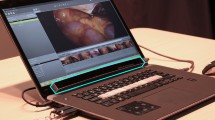Abstract
Introduction
Eye-gaze technology can be used to track the gaze of surgeons on the surgical monitor. We examine the gaze of surgeons performing a task in the operating room and later watching the operative video in a lab. We also examined gaze of video watching by surgical residents.
Methods
Data collection required two phases. Phase 1 involved recording the real-time eye gaze of expert surgeons while they were performing laparoscopic procedures in the operating room. The videos were used for phase 2. Phase 2 involved showing the recorded videos to the same expert surgeons, and while they were watching the videos (self-watching), their eye gaze was recorded. Junior residents (PGY 1-3) also were asked to watch the videos (other-watching) and their eye gaze was recorded. Dual eye-gaze similarity in self-watching was computed by the level of gaze overlay and compared with other-watching.
Results
Sixteen cases of laparoscopic cholecystectomy were recorded in the operating room. When experts watched the videos, there was a 55 % overlap of eye gaze; yet when novices watched, only a 43.8 % overlap (p < 0.001) was shown.
Conclusions
These findings show that there is a significant difference in gaze patterns between novice and expert surgeons while watching surgical videos. Expert gaze recording from the operating room can be used to make teaching videos for gaze training to expedite learning curves of novice surgeons.




Similar content being viewed by others
References
Nodine CF, Kundel HL, Toto LC, Krupinski EA (1992) Recording and analyzing eye-position data using a microcomputer workstation. Behav Res Methods Instrum Comput 24:475–485
Land M, Mennie N, Rusted J (1999) The roles of vision and eye movements in the control of activities of daily living. Perception 28:1311–1328
Law B, Atkins MS, Lomax AJ, Wilson J (2003) Eye trackers in virtual laparoscopic training environment. In: Westwood JD et al (eds) Medicine meets virtual reality. IOS Press, Amsterdam, pp 184–186
Dempere-Marco L, Hu XP, MacDonald S, Ellis S, Hansell D, Yang GZ (2002) The use of visual search for knowledge gathering in image decision support. IEEE Trans Med Imaging 21(7):741–754
Richstone L, Schwartz MJ, Seideman C, Cadeddu J, Marshall S, Kavoussi LR (2010) Eye metrics as an objective assessment of surgical skill. Ann Surg 252(1):177–182
Wilson MR, Vine SJ, Bright E, Masters RS, Defriend D, McGrath JS (2011) Gaze training enhances laparoscopic technical skill acquisition and multi-tasking performance: a randomized, controlled study. Surg Endosc 25(12):3731–3939
Tien G, Atkins MS, Zheng B (2012) Measuring gaze overlap on videos between multiple observers. In: Proceedings of eye tracking research and applications. ETRA 2012:309–312
Vassiliou MC, Feldman LS, Andrew CG et al (2005) A global assessment tool for valuation of intraoperative laparoscopic skills. Am J Surg 190:107–113
Martin JA, Regehr G, Reznick R et al (1997) Objective structured assessment of technical skill (OSATS) for surgical residents. Br J Surg 84:273–278
Wilson M, McGrath J, Vine S, Brewer J, Defriend D, Masters R (2010) Psychomotor control in a virtual laparoscopic surgery training environment: gaze control parameters differentiate novices from experts. Surg Endosc 24(10):2458–2464
Acknowledgments
This study was funded by the Canadian Natural Sciences and Engineering Research Council (NSERC) to Dr. Atkins and the Royal College of Physicians and Surgeons of Canada (RCPSC) to Dr. Zheng.
Disclosures
Drs. RS Khan, G Tien, MS Atkins, ON Panton and AT Meneghetti have no conflict of interests or financial ties to disclose.
Author information
Authors and Affiliations
Corresponding author
Rights and permissions
About this article
Cite this article
Khan, R.S.A., Tien, G., Atkins, M.S. et al. Analysis of eye gaze: Do novice surgeons look at the same location as expert surgeons during a laparoscopic operation?. Surg Endosc 26, 3536–3540 (2012). https://doi.org/10.1007/s00464-012-2400-7
Received:
Accepted:
Published:
Issue Date:
DOI: https://doi.org/10.1007/s00464-012-2400-7




